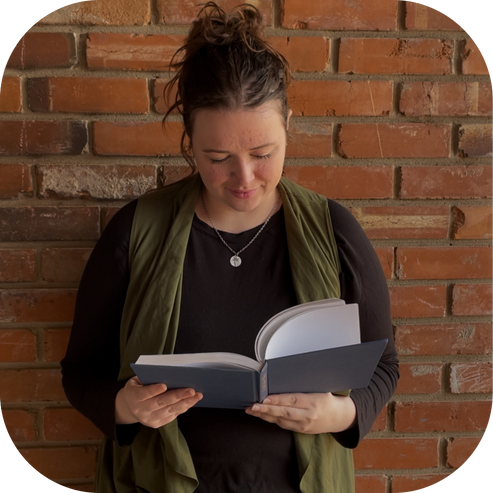3 Months to Published: A Guide to Write A Book

My first book took me years of dreams, months of writing, weeks of editing and endless revisions before I could finally publish. My second book? From idea to published, only 90 days. You could chalk it up to magic, to perfect timing, or maybe skill (I promise it’s not this one); but what if I told you that in those 90 days I went on a 2 week road trip with my family, celebrated 2 major holidays (Thanksgiving & Christmas) and wrote the entire book by hand?
There is a common misconception in the writing sphere that to write a book you have to have plenty of uninterrupted time to write your book and deliver the highest quality words to your readers. While this would be absolutely ideal it is rarely the case for any author.
Writing a book shouldn’t be something that feels impossible, unattainable or daunting. Sure it can be scary to be vulnerable in print but the process of writing your book should not strike fear in you.
So, how can you overcome those negative feelings and successfully write a book in 90 days?
The Standard
The average book takes about 6 months just to write. publishing is much more involved than writing a book and is a different process for everyone heavily dependent upon the authors decision to go the route of traditional or self-publishing.
In my case, I am a self-published author so my timeline is automatically shorter than a traditionally published author as I’ve cut out the middle man. This was also my second book so I was already familiar with the process and knew how to plan properly.
The good news for you is you don’t have to be writing your second book to know the process and plan properly. You’re smart, you’re reading this and taking my experience and using it to get ahead of the curve.
While every author must develop their own process to an extent, learning from others process’ and experimenting to find your perfect fit will cut down your process time drastically.
BREAKING THE STANDARD
There are 5 key steps that I believe were crucial to my success in writing my book in the short time frame that I did.
- Outlining
- Handwriting
- The Right Topic
- Expertise
- Writing Sessions
Each of these steps played a role in the whole writing and publishing process. For you they might each look a little different and in all honesty they have each changed a bit with each book I’ve written as my process has become more refined. So, read through this and ask yourself “How would the basic principle of this step apply to my writing process?” and as always be willing to experiment and learn from your mistakes as you go.

Outlining: The Best Shortcut
I’m a planner so outlining comes really easily to me. I know that’s not the case for everyone and if it’s not for you let me encourage you to give it a try anyway. Outlining has been the best shortcut to success!
Remember how I said that I took a 2 week road trip during my 3 month writing process? Well during those 2 weeks I actually wrote the entire 1st draft of my book. I was able to do this because I had put in the time and work to create a detailed outline.
I outline with sticky notes and those tri-fold presentation boards you had to use in school as a visual aid. It turns out that visual outlining works best for me, if you are not a visual person then you will have to find the outlining method that works best for you but the information you need in your outline will stay the same.
In my outline I included every:
- Quote
- Fact, Statistic, Data Point
- Sub-topic
- Bible Verse/Biblical Illustration
- Personal Story/Entertaining Illustration
For each of the above categories I assigned a particular color of sticky note. Then I wrote each item individually on the corresponding sticky note color. I had a particular “quota” or desired number of each category in each chapter and creating a color coded system made quickly determining if I had enough of each category very simple.
After I write out all my sticky notes I arrange them on my presentation board. I organize them in vertical columns with the chapter number or title at the top of the column and the corresponding sticky notes going down in order of when I want to use them in the chapter.
By doing it in order I am building myself a “connect the dots” of sorts where all I need to do is write the connections between the thoughts and information I’ve already curated. Finally, I take a picture of the board on my phone so I can have it with me while I travel or if I happen to have a chance to write somewhere other than my desk at home where my outline board lives.

Journey Notes
Whether you’re writing your story, chasing your dream, or simply craving more peace and clarity—get weekly encouragement and resources sent straight to your inbox.

This outlining process may sound a bit overboard but it was immensely helpful when I’ve written my books. All I had to do was pull out my phone, notebook, pen, and write. Quick and simple.
It made me feel like most of the heavy writing was already done because I had a clear path from beginning to end and I already knew what key topics and information I wanted to include and bonus it was already written out for me.
Outlining is an essential part of my writing process no matter what I’m writing. I outline my blog articles with the same key categories, I don’t use a presentation board to outline them but I do write out on paper the outline in the same way; headings at the top, information underneath and everything in order.
Handwriting: Do It Old School
There is no other feeling I can compare with the feeling of putting pen to paper. In the 2000s there was a movie called Maid in Manhattan. In it, a man was explaining to a kid that he often gets nervous when speaking publicly.
The man then shares his “secret” to overcoming that nervousness is a paperclip. He holds the paperclip in his hand and imagines it acting “like a lightning rod” pulling the nerves out of him so he can focus on what he is saying.
When I first watched this scene I knew it was powerful but I couldn’t quite put my finger on how it applied to me, until now. I believe that a pen acts as a lightning rod for creativity. When you use a physical pen (or pencil I guess, but pens are better in my opinion) you are drawing your creative nature out of yourself and pouring it onto the page through the ink.
When I wrote the first draft of my book I wrote it by hand. (In a moving vehicle by the way, which I don’t recommend if you want to be able read it later on.) All I used was a spiral notebook and a ballpoint pen.
When you are writing your first draft you have to have permission to get messy, to be imperfect and explore where the book will take you. Of course you have your outline to keep you on track if you walk too far off the beaten path but in the end your first draft should be an adventure!
Writing a book is like giving birth to something new. The world has never had a book like yours, and you’ve never written a book like this one; sometimes that means taking turns and getting lost in the words for a while. This is so much easier to do when writing by hand, it is the lowest friction form of writing and it utilizes your brain in a way using a computer does not.
Computers have their place in the process to write a book and publishing but I don’t believe they have any business involving themselves with your first draft. They are incredibly helpful when editing (though I do this by hand at least once as well) and obviously when formatting your book.
But, as I said, your process may be different than mine so the basic principle here is to utilize a low friction writing method that allows you to get messy when you write your books first draft and remove as much pressure as possible. What could be lower stakes than a school notebook?
The Right Topic: Right Words, Right Time
I keep a “big book of ideas” where all of my book ideas are written out to be used when I can. One of the keys to me writing my book so quickly was choosing a topic I was actively interested in at that exact moment. I didn’t have to force myself to write about it, I didn’t have to trudge through the research and outlining phase. Instead I was already researching and keeping notes on the topic and my experiences with it.
The topic was procrastination and I was fresh off of writing my first book which I had heavily procrastinated so the topic felt very timely. If I had chosen to write on a different topic I don’t believe I would have had the same speed and ease of writing that I did. This begs the question “how do you choose the right topic?”
Start with what sparks your interest, what gets you excited, What are you actively learning right now? If you are anything like me it often feels like life is going through seasons and each season I am learning a particular lesson so I often find myself writing about that lesson. In real time I write about it on my blog or my weekly Journey Notes but after the season is over and everything is still fresh is the perfect time to write a book. A complete chronicling of the entire process and lesson.

Become Undistractable
Learn to identify and overcome distractions, free your time, and enhance your focus.
Bottom line: don’t push yourself to write about something because you think you “should.” If you have to force it, it’s probably not the right book for right now.
Expertise: Know Your Stuff
Productivity and procrastination are major topics of interest in my personal life. I’ve studied, read and learned about both for years before I wrote my book on the topic. Because I had spent so long investing in knowledge on the subject writing about it came “easily.” Knowing all I did also made the outlining process quick and simple, I already had plenty of quotes, sub-topics and verses off the top of my head that I knew I wanted to include because I had been using or living them in my personal experience.
For example one of the subtopics I knew I 100% wanted in the book was the fear of success. This was something I had struggled with myself and I had found it difficult to find information on, I also knew (from my experience) that it wasn’t often talked about and therefore can too often go unnoticed or acknowledge.

I also knew I wanted to include statistics on distraction and specifically social media because it is a pet peeve of mine. Knowing this I already had the seed of a book ready to be planted. I had the overarching topic of which I was already knowledgeable and 2 subtopics I was sure I wanted to include.
Because I was so passionate about the topic anything that ended up being “missing” in my outline, or gaps I found when writing were easily filled in the moment without feeling derailed or like I needed to do more research. Choosing a subject or topic that you have a personal connection to, experience with or knowledge on (which doesn’t have to be doctorate level by the way) will speed up the writing and therefore the entire publishing process.
Writing Sessions: Do it Intensive Style
My road trip, though it would seem it made things more challenging, was a blessing in disguise. On road trips I frequently lose service on my phone so that distraction was removed. I wasn’t driving, so that wasn’t a distraction either. I decided ahead of time that instead of downloading movies or reading for the entire drive I would write a book.
We loaded up in the car; I popped in my AirPods and put my pen to work.
After a few 8+ hr drive days I had my 1st draft completed. I learned that putting in consistent work during uninterrupted writing sessions is incredibly valuable when writing in a short time frame.
The process to write a book is exhausting and will drain you of focus and willpower quickly. That’s why I prefer to set aside a few days to do intense extended writing sessions to knock out large writing projects rather than spreading it out in smaller writing pockets if I can. Carving out large time blocks cuts down on how many sessions I need and combines all the exhaustion into one week rather than several.
For you, being intentional to schedule time to write when you won’t be interrupted can make all the difference. If you can’t or don’t want to have a few writing intensive sessions I suggest writing for 20-60 minutes each day and writing for one-two hours on weekends.
This is all completely dependent on your schedule and preferences. Intensive writing sessions worked for me but they may not for you. Don’t feel pressure to write a book using anyone else’s methods but your own.
Your Own Timeline
At the end of the day it doesn’t really matter how long it takes you to write a book, what matters is that you write it. A 3 month process is helpful in that it allows you to write more in a shorter amount of time but it is not necessary.
You can write a book in 90 days!
However, if you spend the next 3 years writing, it is not a problem or failure on your part. Write your book the way you want to. Take as long or go as fast as you want to. The world needs to hear your story, we need your words of wisdom and your unique perspective is the breakthrough someone is waiting for so stop waiting to share it. Write your book now.
If you’re looking for a step-by-step look at the entire book writing journey check out this article.



